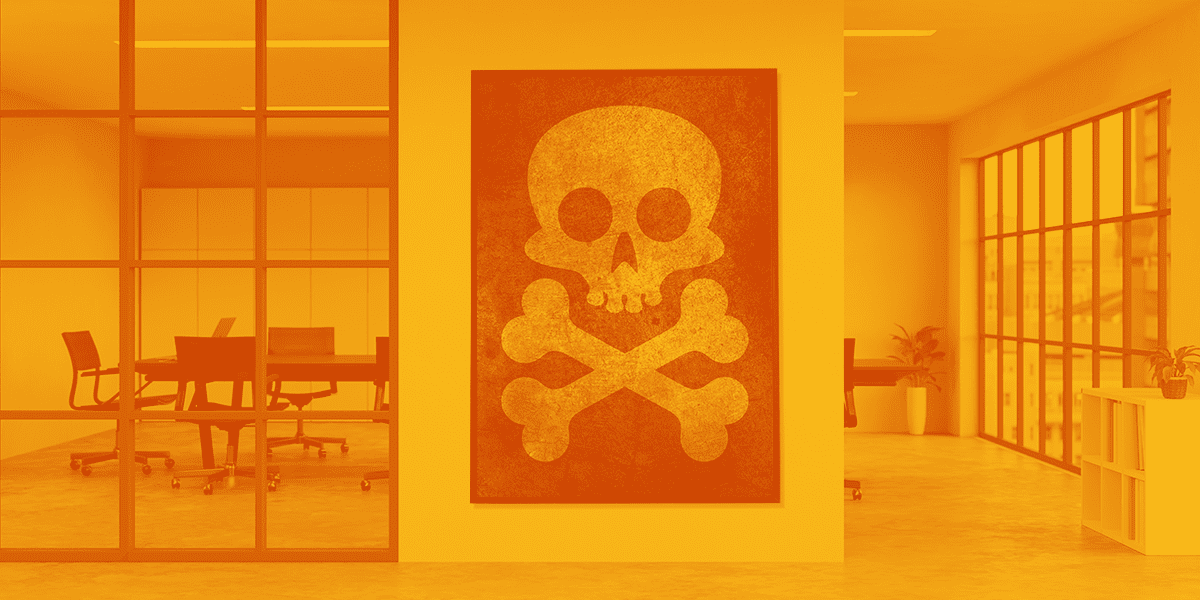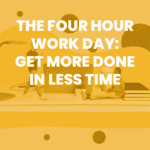Table of Contents
Dolly Parton wrote a song about it. TV shows are created about it. For decades, society has been based around it. But I’m here to tell you: the traditional 9 to 5 is dead. 💀
This probably doesn’t come as a shock to anyone.
For the past decade or so, we as a society have been moving away from the standard eight-hours-a-day, five-days-a-week model (though many corporations have been trying to slow that process as much as possible).
It started with side hustles and remote work. Then COVID kicked it up a notch and forced us all to consider the workday differently, whether that meant working at the times that suited us or working from home instead of the office.
For older generations, this has been jarring. I’ve encountered many people in the workplace who are trying to bring it back to the way it was: clock in at 9 a.m., clock out at 5 p.m. and take a one-hour lunch break in the day. However, for the majority of us, it’s a brave new world where we have more options than ever when it comes to how and where to work.
Good news: Work in 2024 is completely different compared to 10 or 20 years ago. If you’re weighing your career options—or just considering a change—there are plenty of 9 to 5 job alternatives on the table.
But first, let’s look at how the 9-5 became such a fundamental part of the American experience. Because it wasn’t always this way…
Why do we have 9 to 5 in the first place?
While we think of the typical 9 to 5 as a grind today, it was actually a massive improvement to the way things were before. In fact, the concept of an eight-hour workday was first floated by the National Labor Union in the 1800s as a way to protect workers’ rights.
Before this, many factory employees were working 100+ hours over six days every week (crazy, I know).
And yet the idea didn’t REALLY get legs until the Ford Motor Company introduced the concept of a 40-hour work week in the 1920s—and then followed that up with a reduction from a six-day workweek to five days.
This simple idea quickly caught on. Congress passed the Fair Labor Standards Act in 1938, limiting the work week to 44 hours. Two years later, this act was amended to 40 hours—and we ended up with the 40-hour work week we know now.
So, when you think about it, the 9 to 5 was actually a massive change for the better, not the worse. This change cut work hours down dramatically, giving people more time to enjoy themselves (or heck, even to sleep).
Here’s the thing, though…
9 to 5 was the product of the industrial era where quantity, not quality, was the name of the game. The more people you had and the longer they worked, the better because it meant more output.
Today, the work landscape looks a little different.
While there are still jobs that involve manual labor, many roles out there require us to use our minds. Unlike assembling items on a factory floor, modern jobs require us to solve complex problems, collaborate with others, or focus on the task at hand…and this is where 9 to 5 falls short.
Five big problems with the traditional 9 to 5
1. It’s inefficient
Think back to the last full eight-hour day you worked.
How many hours in that day were actually productive?
Six at best, according to studies. Productivity starts to dip after 30 hours a week and grinds to a dead halt at 55. That means that in any given 40-hour work week, a quarter of your time is wasted simply because humans can’t operate at maximum efficiency for that long.
What’s more, research has shown that the most productive employees engage in focused work for 52 minutes, then take a 17-minute break.
The truth is our brains weren’t designed to focus for long stretches of time. Like a phone, our mental capacity depletes over time and needs to be recharged before it’s ready to go again.
Asking people to work 9 to 5 automatically sets them up to be unproductive because it goes against the very nature of how we humans work best.
By the way, if you’re looking to become more productive without working yourself into the ground, check out these articles:
2. It doesn’t account for different work styles
I’m insanely productive between the hours of 8 a.m. to midday. After lunch, however, it’s a different story. The amount of work I can do slows to a crawl. What takes me one hour in the morning might take two, three, or even four hours in the afternoon.
With my partner, it’s completely different.
He has self-proclaimed that he is “useless” before midday. His brain only starts to warm up in the afternoon and really kicks into gear around 7 p.m.
What happens in the evenings? He works like a machine and gets some of his best work done in the middle of the night.
That’s another problem with the traditional 9 to 5: it lumps us all together and forces us to work at the same time, regardless of personal preferences or capabilities.
There are very few people who can be productive for the entirety of a 9-5 job. The best employers (but still far too few) understand this, and give their employees opportunities to adjust their hours to maximize productivity.
3. It’s not ACTUALLY 9 to 5
It took me awhile to realize that the traditional workweek is actually more of a time-sink than we think.
That’s because, on top of spending eight hours at work, we have to account for the additional time it takes to get to and from work. If you live in a major city, this could be anywhere from 30 minutes to an hour and a half every day.
Add that up over five days, and you’re losing almost a day just getting to work.
On top of that, it’s very common for people to come in early or stay late to finish up projects at work. Even if that’s only an hour or two of extra work per week, that adds up! Do that over the course of a full year, and you’ll lose about two full weeks beyond your paid working hours. (And you can bet your employer wouldn’t grant you two full weeks off without docking your pay!)
4. It puts the focus on time, not output
At the beginning of my career, I would always get things done quickly and get asked to do more, while other colleagues would work at a slower pace.
Here’s the catch…
We were all being paid for the same amount of time.
At a certain point, I stopped doing things as quickly because I wasn’t getting compensated for being more efficient with my time than others.
When I first started freelancing, it was a game changer.
I charged by project, got my work done quickly, and got paid for the output. I suddenly had so much more time in the day, and I was earning the exact same amount as I was in the office. For once, I felt like my efficiency and output capabilities were a benefit—not something I had to suppress to prevent myself from working twice as hard as others in my office.
The eight-hour workday pays for the time you spend at work, not the amount of work you get done. Oftentimes, this incentivizes people to do less, not more, or to run out the clock on any given day.
Add on the fact that most 9-to-5 jobs are expected to be in the office, and you have a lot of people who just show up to clock in their hours and leave.
5. For a lot of people, it’s just too much work
Have you ever found yourself killing time at work, moving your mouse around your screen to look busy, because you’d finished all of your tasks ahead of time?
Or maybe you dread going in to work every day, because you’re feeling all the signs of burnout at once. (I’ve been there, trust me.)
Don’t worry—it’s not just you. For many people, perhaps even most people, a 40-hour work week is simply too much work. When you think about it, working 40 hours means you’re spending more time with your colleagues than your loved ones.
Spending a third of your life working for someone else often leads to burnout, because it doesn’t leave enough time for the things that truly bring joy in life: friends, family, passion, creativity, and the art of simply doing nothing but relaxing.
Sure, the 40-hour work week was an improvement over the brutal expectations put on workers before labor reform. But it doesn’t take much time working at a 9-5 before you realize that 40 hours a week is bad for the human spirit, and doesn’t lead to more productivity (as much as employers want to believe it does).
So, what should we do instead? Eight 9-to-5 job alternatives
If you do enjoy the traditional 9 to 5, then good on you! Keep doing what you’re doing and enjoy your work week (and your time off). However, if you’re looking for a different approach to work in the future, here are eight options worth exploring instead.
1. Hybrid work
Let’s start with the most common in 2024: hybrid work. A mix of working online and working in the office, hybrid work first rose to popularity in the tech boom, but it really took off when we returned to work after COVID-19.
Hybrid work allows you to have the best of both worlds: you can go into the office and do your 9 to 5 on some days and work from another location or at other times during other days. This is perfect if you want to try out a different way of working without fully committing to remote work.
Your employer may already offer hybrid options, but if not, there’s no harm in asking your direct manager to see if they might consider it.
Finding hybrid roles is a lot easier than it used to be. Most job boards now allow you to filter for hybrid, remote, or in-office jobs, and job listings will put it front and center. If a job post doesn’t mention hybird or remote working options at all, that’s a good indication they probably prefer the old-fashioned way of working—but it’s still a good question to ask in an interview!
2. Remote work
If you’ve ever considered remote work, I’m here to tell you that the benefits are definitely worth it.
I worked remotely for three years while traveling and loved the freedom and flexibility that came with it.
Remote work allows you to work where you want when you want. You could work from home or in Bali. Work in the morning or at night. Work for half the day, then take a break and pick up later in the evening.
The best part about remote work is that you cut out the entire commute time—easily winning back half a day or even a full day in your week.
That being said, remote work takes a lot of discipline, as you won’t have a manager or other colleagues helping you stay on task. So be sure to check out our digital nomad survival guide if you’re considering this 9-5 job alternative.
3. Freelancing
In 2023, there were around 73 million people in the U.S. freelancing. In 2024, that number is projected to grow by another 3 million.
The reason for the rise of freelancing is simple: This style of work gives you more control over the type of projects you work on and the clients you work with. Plus, you get to set your own hours.
When I was freelancing, I’d go from working four hours a day, four days a week when I wanted more balance, to seven days a week when I wanted more money.
Having the option to work on your own terms is incredible, but be warned. It takes time to establish a stable gig, which is why you might want to start freelancing on the side.
If so, here are a few resources to help out:
4. Contracting
Contracting is similar to freelancing, but you’re typically engaged by a company to work on a specific project or for a specific period of time (for example, maternity leave cover).
Contracts are great if you want the stability of a full-time or part-time job but don’t want to commit to one company. You get to work on a wide variety of projects, meet new people, and add a ton of skills to your resume without the long-term commitment that comes from permanent roles. Contractors often get paid higher rates as well because they don’t get the same benefits as a full-time employee.
5. Part-time work
Full-time jobs are typically the go-to for graduates, but don’t write off a part-time job. These jobs are great if you’re not sure what you want to do.
At the beginning of my career, I worked part-time at two companies: one in PR and one in digital marketing. Doing both gave me valuable experience and allowed me to figure out which field I preferred. Plus it kept the week interesting.
Part-time work is also good if you want more time to study, do your hobbies, or pursue your side hustle.
Speaking of which…
6. Side hustles
Ah, the infamous side hustle.
It seems everyone has a gig on the side these days, from making jewelry on Etsy to delivering UberEats or launching a Youtube channel. Having a side hustle is a great way to earn some extra cash, start a new career, or build your own business without completely losing all of your income.
The best thing about the side hustle is that there are more options than ever before. Check out these 15 side hustle ideas—you might even find a new job out of your side hustle.
7. Entrepreneurship
If you have the drive to run your own business, then you may want to consider entrepreneurship as your alternative to a 9-5 job. Unlike freelancers, who rely on their own skills to deliver work and earn income, entrepreneurs are focused on building a full-fledged business, whether or not they are the ones delivering the goods.
For example, entrepreneurs might start an online retail business, or build an agency that employs full-time, part-time, or freelance employees to deliver the work. They might create a new product, like an app or piece of software, and turn that into a business. Entrepreneurs can also open up their own brick-and-mortar companies, offering direct services to people in their region.
There’s no limit to what an entrepreneur can do, but it will take time, effort, planning, and potentially an investment of your own money. Many entrepreneurs start out as freelancers or working on a side hustle until it can replace their other jobs.
If entrepreneurship interests you, these resources can help:
8. Four-day work weeks
Just like Ford did in the 1920s, companies are now experimenting with reducing the number of hours in the work week to make sure work hours are relevant for today’s workers.
A series of trials around the globe are being organized by a non-profit called 4 Day Week Global, which claims that employees experience higher life satisfaction and no loss in productivity compared to those who work five-day weeks.
Microsoft Japan and Unilever Australia are some of the big names that have tested the 32-hour work week—and more companies are joining by the day. If you’re looking for an alternative workplace arrangement (or negotiating your current one), it’s worth seeking out employers open to this type of setup.
We have more options than ever before
No matter what option you choose, there’s never been a better time to experiment with when and how you work. Make 2024 your year to try something new. Start the side hustle, switch to remote work, or look for a new job that works best for you.




















